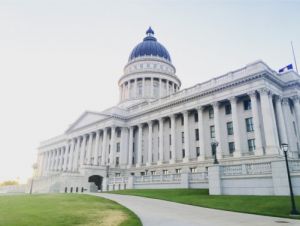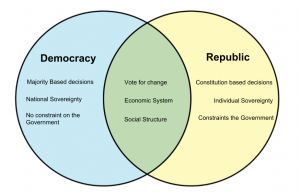Difference between Republic and Democracy
In this article, we will illustrate the differences between a democracy and republic. The main difference between a democracy and a republic is the limitations placed on governments by the law. A democracy is a government system where all eligible citizens have equal rights to participation, development and creation of laws either directly or by chosen representatives. It is a government of the people where the voice of the majority rules. A republic refers to a government with a chosen head of state that serves for a limited term. Even in a republic government, the voice of the majority rules. However, there are laws protecting the rights of the minority. It is easier to think that the two systems are mutually exclusive but they often overlap in many situations.
A republic is a form of representational democracy with some laws that check and balance the constitution to make sure the rights of the minorities are protected. The United States is a republic. It is common to hear American politicians referring to the U.S as a “democracy”. However, what they are referring to is a representational democracy which is the same as a republic.
There are many political implications that come with the U.S being a republic. Laws voted for by the majority could be challenged if they violate the U.S constitution and therefore could be overturned. Democracies are believed to be here longer than republics. It is however difficult to tell exactly where each system started. Many countries and cultures have both democratic and republican characteristics. The most well documented early democracy was found in Greece and the most well documented historical representational republic is the Roman republic. Although the word democracy is quite popular and the desire to achieve democracy is common, most countries today are republics operating under a presidential system.
| Democracy | Republic | |
|---|---|---|
| Definition | The majority rules supreme. | A representative democracy limited by the establishment of a written constitution. |
| Social structure | Class distinctions may be prominent in capitalist societies. | Class distinctions may be prominent in capitalist societies. |
| Constraints on the government | No. | Yes (Constitutional Constraints). |
| Religion | Religious freedom is the norm unless in cases where the majority chooses otherwise. | Religious freedom is the norm unless this is limited by a constitution. |
| Political System | Democratic (this is a system, not the party). | Republican (this is a system, not the party). |
| Example | Mainly capitalism or Keynesianism. | Mainly capitalism or Keynesianism. |
| Famous Examples | Rome, Classical Greece. | United States Of America, France, Rome. |
| Sovereignty is held by whom. | The citizenry (as a group). | Individual citizens. |
| Key element | Free elections. | Free elections guided by a constitution. |
| Modern examples | US, Japan, New Zealand, Canada, Australia, Western Europe etc. | The US, Mexico, Italy, Portugal, Germany, Poland, etc. |
| Free choice | Yes, unless limited by the majority. | Yes unless limited by a constitution. |
| Variations | Direct democracy, representative democracy, parliamentary democracy. | Constitutional republics, Democratic republics. |

